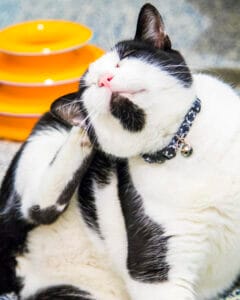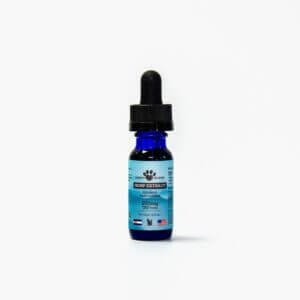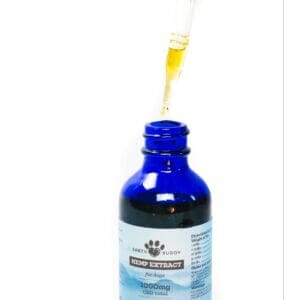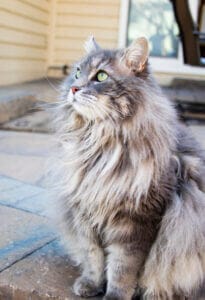
We’re so caught up in our busy world that sometimes we forget to ask how things work. Instead, we’re just focused on why something is important and how to take care of it. Of course, that’s important too. But going back to the basics is important to fully understand how to care for your pet.
For example, we know we should be brushing our cat daily, but have you ever stopped to think, “why do cats shed?” Taking it back to this fundamental question and building on your knowledge can help you care for your pet better than ever. It encourages a more mindful approach to pet care, where understanding the ‘why’ behind the ‘what’ leads to a more enriching and fulfilling relationship with our pets.
Why Do Cats Shed?
Shedding is a natural process that helps cats eliminate dead hair and promotes the release of oils from their skin, contributing to a healthy skin and coat. When cats groom themselves or are brushed by their owners, this dead, loose fur from your cat shedding is removed. Any loose hairs that aren’t removed during these grooming sessions will eventually end up on your floors, furniture, or in the environment.
On top of ending up throughout your house, if this dead, loose hair isn’t effectively removed (especially when your cat is shedding), it can affect the health of your cat’s hair coat, leaving their coat looking unkempt, shaggy, and scruffy. They may even have odd hair length along different parts of their bodies.
Expanding on this, regular normal shedding and grooming are essential not just for cleanliness, but also for your cat’s overall skin and coat health. The act of shedding and grooming helps distribute natural oils throughout their coat, helping cats achieve a soft, silky, shiny and healthy coat.
For indoor cats especially, regular brushing by their owners is crucial as it aids in the removal of excess fur that they might otherwise ingest during self-grooming. This may help prevent and eliminate hairballs as your cat loses hair. This process also provides an opportunity to check for any skin issues, lumps, or parasites.
How Much Shedding is Normal in Cats?
If you have long haired cats, it’s likely they will shed more than your shorthaired cats. For example, a Maine Coon with thick fur will shed more than your traditional Domestic Shorthair. Other cat breeds that tend to shed significantly include Persians and Ragdolls. You’ll notice little cat hairs all over your clothing, furniture, and maybe even in the corners of your staircase. That much hair loss during shedding is generally normal.
If you notice large chunks of fur, or more hair than they generally release during shedding seasons in the past, that’s when the amount of hair loss may not be normal. Debris in the fur could also be a red flag. Making an appointment with your vet is important if you have any concerns.
When Do Most Cats Shed The Most?
Much like dogs, cats tend to have two peak shedding periods throughout the year, which typically occur in the spring and the fall. These times are quite logical when you think about the seasonal changes they correspond with.
In the spring, cats shed their thick winter coats to make way for a lighter covering that’s more suitable for the warmer weather. This helps them stay cool and comfortable as temperatures rise. Then, as fall approaches, they start to grow a heavier winter coat in preparation for the cooler months, ensuring they have sufficient warmth during the winter.
However, this natural shedding cycle can vary, especially for indoor cats or if your outdoor/indoor cats tend to spend most of their time inside. Cats that spend most (or all) of their time indoors can experience a different shedding pattern.
The controlled climate of a house, with air conditioning in the summer and heating in the winter, along with exposure to artificial lighting, can disrupt their natural body rhythms. This disruption might lead to a more constant shedding cycle throughout the year, rather than the pronounced seasonal shedding seen in outdoor cats.
For indoor cats, this means that their ‘seasonal shedding’ might not align perfectly with the spring and fall patterns. It’s important for cat owners to be aware of this, as it can require more consistent grooming and care year-round. Regular brushing becomes even more crucial to manage shedding and maintain a healthy coat, regardless of the season, to remove dead hair.
Excessive Hair Loss And Excessive Cat Shedding
If you look around and think ‘why is my cat shedding so much?’ and see so much hair lying around through the house, take a look at what your cat is experiencing. While excessive shedding can be cause for alarm, but there are situations where excessive cat shedding could be expected.
If there’s a health concern, it’s important to remember to check with your veterinarian or veterinary nutritionist. That being said, there are several factors that could contribute to result in excessive shedding in cats, including:
How Food Quality Affects Cat Hair
A poor diet can significantly impact your cat’s shedding, often resulting in an increase in the amount of fur found around your home. Providing your feline friends with high-quality, species-appropriate food is crucial for maintaining healthy skin and a healthy cat coat. A diet that is well-balanced, provides variety, and that’s tailored to the specific nutritional needs of cats can lead to a noticeable difference in their coat’s condition.
Cats require certain nutrients, including proteins, fatty acids, vitamins, and minerals, to maintain a healthy coat and skin. A species-specific diet is rich in omega fatty acids, vitamins and minerals essential for healthy skin and coat. A diet lacking in these key nutrients can lead to an unkempt looking feline. Filler ingredients in cat food can also contribute to a damaged coat. It’s important to choose cat food that avoids common fillers and preservatives.
In some cases, specialized diets may be necessary, especially for cats with specific health concerns or sensitivities. Consulting with a veterinarian can provide guidance on the best dietary choices for your cat’s unique needs. They might recommend certain cat supplements or a particular type of cat food that would be most beneficial for your cat’s coat health.
Regular monitoring of your cat’s coat condition and your cat’s shedding patterns, along with attention to their diet, is an essential aspect of pet care. By ensuring your cat consumes a nutritious and appropriate diet, you can help reduce your cat’s excessive shedding and promote skin health.
A Cat’s Hair Loss in Senior Cats
As cats age, a notable change in their grooming habits often occurs. They may start grooming themselves less frequently, which can lead to several issues with their fur. One of the most common problems is matting or tangling of their coat. This happens because, without regular grooming, their fur can become knotted and clumped together. Their tongue acts as a sort of brush and, without it (and without your help), it can easily go beyond their ability to self-groom.
Matted fur is not just an aesthetic issue; it can cause occasional discomfort, as mats can pull on your cat’s skin. Mats can also trap dirt and debris, allowing toxins to attach to the coat and skin.
You might observe that, instead of the usual small amounts of cat hair on furniture or clothing, large clumps of fur begin to appear around the house. This can be a sign that your cat’s coat health is declining due to their reduced grooming activity. As cats age, they may face other health challenges, which can make the physical act of grooming even more difficult.
Cat Shedding During Pregnancy
Pregnant and lactating cats often experience a higher rate of shedding compared to other cats, primarily due to the significant hormonal changes occurring in their bodies. During pregnancy, a cat’s body undergoes various adjustments to support the development of kittens. These hormonal fluctuations can affect the cat’s fur, leading to an increase in shedding. This is a natural response as the body adapts to the changing needs during pregnancy.
Similarly, when a cat is lactating and nursing her kittens, her body continues to experience hormonal shifts. These changes are not only crucial for promoting milk production but can also impact the cat’s coat. Lactation requires a considerable amount of energy and resources from the mother’s body, and this can manifest in her fur’s health and shedding patterns.
Excessive Grooming in Cats
Excessive grooming could occur as a result of a cat’s behavioral issues, but before you look into behavioral reasons, it’s important to contact your veterinarian to rule out medical causes. They will likely look for bald spots and anything that looks like skin irritation or skin infections, among other abnormalities.
If you rule out medical causes, it’s time to move on to behavioral causes such as signs of stress in cats. We won’t go into these in-depth, but here are some topics to discuss with your feline behaviorist: repetitive licking, what activities your cat has available (in case they’re bored), obsessive behaviors, if there have been any changes in the household, or any changes in your routine. They will discuss this further with you to determine the next steps.
Grab The Necessary Cat Grooming Materials
Although cats are known for their self-grooming habits, they can still benefit significantly from regular grooming by their owners to remove loose fur, which requires a few essential supplies. A quality brush or comb suited to your cat’s coat type is fundamental. That’s the starting point, but you first need to take a look at what your cat’s fur is like to determine what kind of brush to look for.
For short-haired cats, a fine-toothed comb or a short-bristle brush works well, while long haired cat breeds may need a wide-toothed comb or a slicker brush to gently detangle longer fur. Besides brushes and combs, having nail clippers designed for cats is crucial for keeping their claws at a healthy length.
Investing in cat-safe wipes for cat’s skin and paws or grooming mitts can be helpful for more sensitive areas or for cats that are less tolerant of traditional grooming methods. It’s also a good idea to have cat-specific shampoo for occasional baths, particularly for long haired breeds or cats that go outdoors.
Most Cats Appreciate a Grooming Routine Whether Your Cat is Shedding or Not
Establishing a grooming routine with your cat, especially with your cat shedding, involves patience and regularity. It’s best to start grooming when your cat is young to acclimate them to the process, but older cats can also learn to enjoy grooming with the right approach. Begin with short sessions, gradually increasing the duration as your cat becomes more comfortable.
Whether you have younger cats or older, offer treats and praise to associate grooming with positive experiences. Pay attention to your cat’s tolerance level and try to groom during their relaxed periods, perhaps after a meal or playtime. Regular grooming not only helps support your cat’s coat health but also serves as bonding time and allows you to provide cat stress relief. And it can help them look their best as your cat sheds. A professional groomer can help you learn the right way to care for your kitty’s fur coat.
Adding Supplements To Promote Your Cat’s Coat Health
Incorporating a cat supplement, like full-spectrum CBD oil for cats that also contains MCT oil from Earth Buddy, into your cat’s routine can be beneficial for promoting skin and coat health. The best cbd for cats contains a variety of naturally occurring compounds from the hemp plant, including cannabinoids, terpenes, and flavonoids that work synergistically, promoting your cat’s mental and physical well-being.
One of the key ways full-spectrum CBD oil for cats may benefit your cat’s skin and coat is by supporting normal inflammatory pathways. By promoting a normal inflammatory response, full-spectrum CBD for cats benefits include healthy skin, which in turn can lead to a healthier, glossier coat.
Essential fatty acids for a healthy coat can be found in a high quality hemp extract containing CBD or CBG. These fatty acids, known as omega-3 and omega-6, play a crucial role in helping maintain normal moisture content of cat’s skin. Regular use of a high-quality Hemp Extract for cats can not only support feline coat health, but also assists in the cat digestive system with absorption of essential nutrients promoting overall health.
For further reading, we recommend:
- https://www.sciencedirect.com/science/article/abs/pii/S0300962996001132
- https://www.sciencedirect.com/science/article/abs/pii/S0007193517358359
- https://www.vet.cornell.edu/departments-centers-and-institutes/cornell-feline-health-center/health-information/feline-health-topics/danger-hairballs
- https://www.marvistavet.com/fur-mowing-feline.pml
- https://www.researchgate.net/publication/257646742_Evaluation_of_hair_loss_in_cats_occurring_after_treatment_with_a_topical_flea_control_product
You Might Also Enjoy
Understanding the differences between hemp vs CBD oil is important to produce the outcomes you’re…
The interest in natural options for promoting pet health has seen a significant rise, with…
Reactive dog barking may sound intimidating, but it’s important to differentiate it from dog aggression.…









